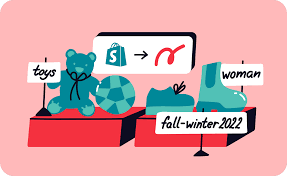
As a Shopify store owner, often you need to organize your products, track inventory and create discount codes. That’s where the product tags come in handy. They also help your customers filter and find desired products and recommendations.
But how do they impact your Shopify SEO? In the article, you’ll have answers to everything about Shopify product tags. Let’s find out.
Table of Contents
What Are Product Tags?
Product tags are labels to classify your Shopify products. They often contain phrases or keywords to help sort and identify items in your store.
For example, if you have a clothes shop on Shopify, you may use keywords like “casual,” “professional,” “red,” “linen,” etc as the product tags. While your site visitors can’t see them, you can use them to categorize products and organize customers’ search results.This way, it becomes easy for your customers to search for and find an item(s) of their liking in your Shopify collection.
Note:
- No matter what your product types are, it is ideal to use your customers’ most used search terms.
- According to Shopify, you can use up to 250 tags to label one product of your store.
Examples of Product Tags
You can come up with custom tags to give identity, personality, and life to your products. Here are some common examples:
- Color: This is common for stores selling items like apparel, where color is a big buyer concern. Your tags can read yellow, green, purple, etc.
- Material: Such tags are helpful when sorting items like seat covers made from different materials. The tags include nylon, cotton, silk, leather, and more.
- Season. This is an ideal way to categorize season-specific products. Use tags like spring, summer, autumn, winter, etc. It will be easy for you to bulk track or hide goods when considering a promo or super sale, as the season ends.
- Price range: These are tags aimed at customers and prospects who budget their expenditures.
- Gender. Apply male, female, and unisex tags to sex-specific items. These can be accessories, clothes, toys, perfumes, etc.
- Age. Differentiate your products based on the age of the intended users. For example, young adults, kids, and adults.
- Style. These come in handy for customers with specific aesthetic preferences like gothic, bespoke, chic and more. Examples include decorations and art pieces, etc.
- Recommendation. Some common tag examples include “hottest”, “top-selling”, “popular”, etc. They help push undecided customers and those who are okay with suggestions to shop. You can also use these tags to market new arrivals.
- Unique qualities. These tags simplify how you find products with outstanding selling points in a Shopify store. A popular example is “100% natural.”
- Offers: They describe a promo scenario when a package goes for a lower price than its usual cost. For example, “free shipping”, “Buy 1 Get 1 free”, etc.
What Are Shopify Product Tags Used for?
Although customers may not always see them, Shopify product tags have paramount importance to ease your pressure in store management. Here are some of its uses:
- Grouping and filtering products
You can use product tags to categorize items by product type or special features like the above, tracking products based on color, size, or price customization. This helps you manage your store efficiently and easily. It also acts as a filter for you and your customers to find the desired items quickly.
- Enabling smooth navigation
This is where you add product tags to your store’s menus to update product navigation and categorization. Your website visitors have a better browsing experience as they are only a click away from their desired product.
- Facilitating catalog management
Tagging products allows you to perform bulk actions on your store items. Say you run a shoe store. When winter is over, you can hide all shoes tagged “winter” in a batch, and launch all “spring” tagged items at once. This reduces your workload and eliminates manual errors, freeing your hands to improve your store further.
- Segmenting customers
Shopify allows you to divide customers into chunks based on their behavioral data and demographics. Upon building new segments, you must modify the product tag in a way that appeals to any particular customer group. For example, the word ‘rainbow’ for a label will appeal to people in the LGBTQIA+ movement.
How To Add or Delete A Shopify Product Tag?
Adding or deleting a product tag in your Shopify store is very easy, taking only a few steps.
How to create a Shopify product tag:
- Head to your Shopify Admin, then click the Product tag. Select the product you want to tag.
- Enter the tag name in the Tag section. Or click View all tags to select an existing tag for editing from the Tag list.
- Click Save.
How to delete a Shopify product tag:
- Open your Shopify Admin and go to the products page.
- Select the product you want to remove a tag from.
- Scroll to find Organization and click X next to the specific tag you want to delete.
Do Product Tags Help Your Shopify SEO?
Yes and no.
In some ways, Shopify product tags can help your SEO efforts. Since they help users navigate through your website smoothly, it enhances the user engagement and experience, which indirectly benefits your store SEO performance.
Shopify automatically creates a new page with your tag inserted in the URL also. This way, these tag pages will be treated as standard content by Google. If your tag pages are well-organized, unique and with high-quality content, it can be a big boost to your site SEO.
However, if your tag pages are almost identical to each other, with the H1, collection description, content, and meta description, etc being the same (which is very likely), it will reduce the overall SEO quality of your website, resulting in wasted crawl budget and missed opportunities as you can’t customize these pages for SEO.
What’s more, tag pages with thin content tend to have keyword stuffing issues, and are likely to be penalized by Google.
How to Use Product Tags To Improve Your Shopify SEO Performance?
There are multiple ways you can maximize the benefits of product tags to your store, while not not being impacted by its downsides. Follow the tips below to handle your product tags, so as to improve your Shopify SEO performance.
- Use rel=” canonical” tags.
This is an HTML tag to help search engines differentiate between the original page and duplicates with similar content.
Whenever you create a tag, there will be a tag url generated. When there are dozens of tag pages with similar content, Google may have difficulty in identifying which page to display first. Canonical tags in such cases, recommend the main version of your content for bots to crawl that one page.
You’ll need to get into your theme.liquid template file and replace <link rel=”canonical” href=”{{ canonical_url }}” /> with:
{% if template contains ‘collection’ and current_tags %} <link rel=”canonical” href=”{{ shop.url }}{{ collection.url }}” /> {% else %} <link rel=”canonical” href=”{{ canonical_url }}” /> {% endif %}
- Use no-index/no-follow.
No-index is often used to prevent pages like internal search results, thank you, and admin and login from showing up in SERPs, since they provide no valuable information, and are unique to individual customers.
You can also noindex the urls of your product tag pages, stopping them from being crawled and indexed by Google.
Simply add this code to your theme.liquid file:
{% if template contains ‘collection’ and current_tags %} <meta name=”robots” content=”noindex, follow” /> {% endif %}
Alternatively, you could apply a rel=”nofollow” HTML tag. Nofollow links don’t transfer PageRank, meaning they have no direct impact on your website SEO.
- Modify robots.txt on Shopify.
A robots.txt is a special file that instructs crawlers on what pages to or not to access on your website. For example, you can create a rule to deny a bot(s) access to your tag URLs or directories. But, you need to be careful because this can cause issues on your site, especially if you use default product links. They could also be blocked from robots. So, I recommend consulting some SEO experts to guide you through.
- Use product tags as keywords in page content, URL, and meta.
Find out which keyword customers use to refer to your products. Use them as product tags and include them in your page’s content, and meta description, etc. This way, the product tags account for mainly a small part of your whole page, which avoids penalties while making your content more targeted.
What to Note When Writing Product Tags?
- Clarity to outside eyes
It is vital to create product tags that resonate with your site visitors. This is especially true if your product tags appear in your Shopify theme’s drop-down menus. You need them to be simple for customers’ understanding. For instance, the correct tag for the 2023 winter jacket collection would be Winter Jacket 2023 and not wtjacket23.
- Keep your tags short and concise
Use tags with no more than 16 characters. That’s because most people use one or two words to search for products on the internet. For example, blue jeans, winter jackets, and more.
- Apply the search terms your customers may use
Ensure you have appropriate product tags that describe your Shopify product with relevant search terms. Find keywords and phrases that are likely to be used by your site visitors. A good way to start is to review the Shopify Behavior Reports to know your customers’ top searches. That lets you analyze their expectations and can improve your product tags using the exact search terms.
Frequently Asked Questions
Q1: How many types of Shopify tags are there?
Shopify has several types of tags, including:
- Product tags. Group and organize your Shopify products into different categories, usually with easy product selection and as filters.
- Transfer tags. Tag transfers made with vendors or locations for better tracking. Examples are “urgent”, “reoccurring”, “incoming stock amounts”, etc.
- Customer tags. Useful for giving relevant details when describing your customers. Some examples are “tax exempt”, “VIP”, “lost”, “returning customer”, etc.
- Blog post tags. If you run a blog along your store, these tags help organize your blog posts. They also narrow down how your site visitors find specific content.
- Order/Draft order tags. These tags allow you to organize orders by fulfillment regions, delivery status, and expected delivery dates. Common examples include “clearance”, “analyzed”, “test”, “packed”, and more.
Q2: Can product tags negatively affect SEO?
Yes. Although product tags are a great practice, they can harm your SEO if you fail to take the right actions. Every time you make a tag, Shopify produces a duplicate page that may confuse Google bots on which page to rank. This is bad for SEO because search engines may show up the page that’s not intended in the top search results.
Q3: Can you reuse Shopify product tags?
Yes, Shopify product tags are reusable. After you create a new tag on your Shopify store, it automatically gets saved for future use, which saves you time, effort and resources.
Conclusion
Without a doubt, Shopify product tags can be a shot in the arm for your SEO efforts. Creating them is easy too. Heed the tips above to use your product tags to boost your Shopify performance.
For more comprehensive SEO efforts, consider leveraging the services of free Shopify SEO booster apps like SEOAnt, which offers image compression and broken link redirects, Alt text optimization, structured data generation among others, to optimize your website in different ways.








